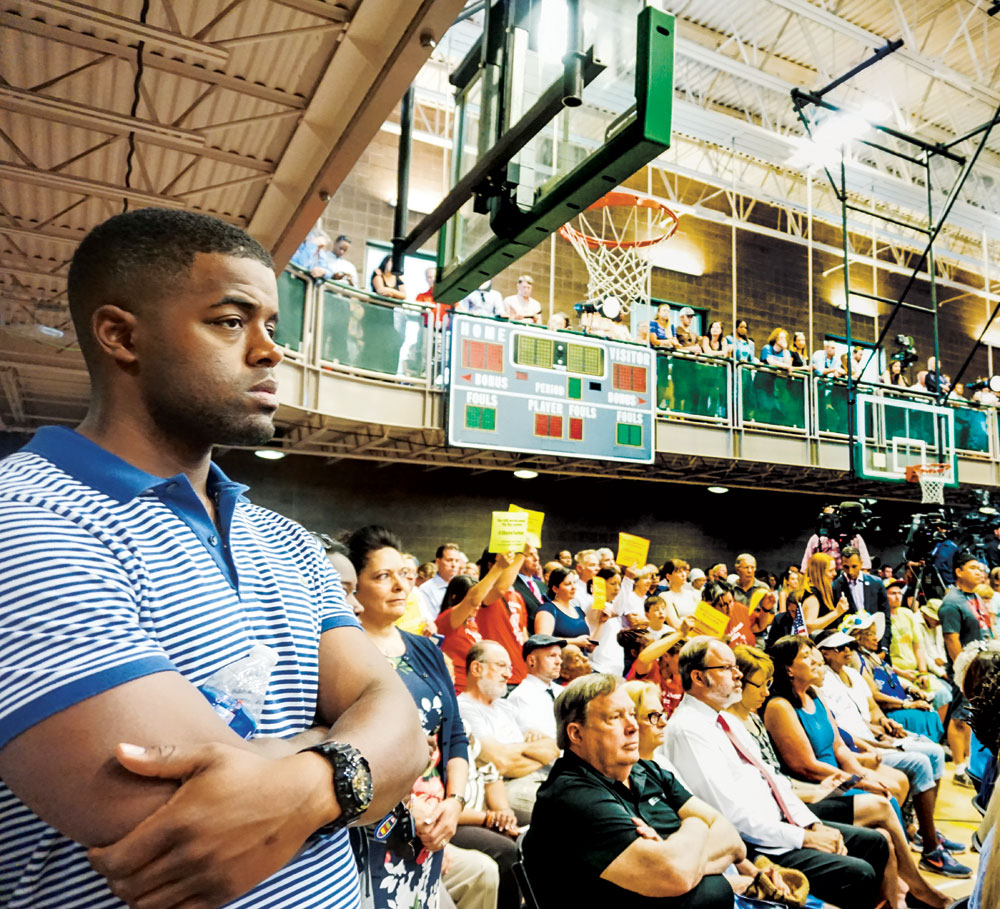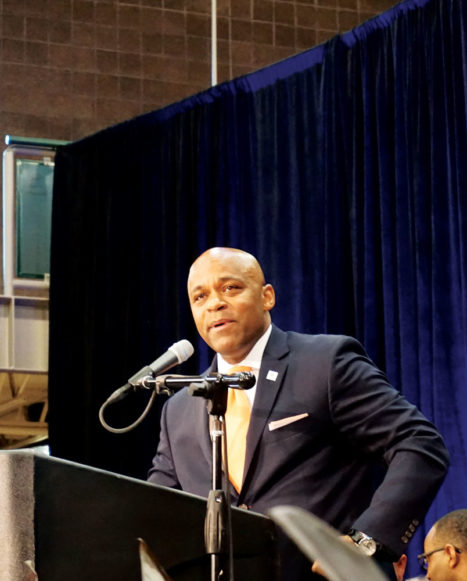
A standing-room-only crowd attended the State of the City speech.
A standing-room-only crowd came to Hiawatha Davis Jr. Recreation Center in Park Hill to hear Mayor Michael Hancock’s State of the City speech on July 10. Affordable housing, mobility, and the importance of public centers were the centerpieces of his address. But the most enthusiastic applause greeted Hancock’s pledge to stand by the Clean Power Plan and the Paris climate accord and his exhortation that “It’s time to stop threatening our cities, stop targeting innocent people, and get to work on real solutions to bring hard-working undocumented people out of church basements, and out of the shadows.”
Hancock opened by reminiscing about growing up in Northeast Denver—playing basketball at the Hiawatha Davis rec center, conversations interrupted by the noise of the old Stapleton airport, lunches at now-closed Pierre’s—to emphasize the tension between the old and the new in a city that has experienced explosive growth over the last several years.
“Today, we face new challenges—like housing, traffic and the need to better manage our growth,” said Hancock. “But no matter how much Denver has changed, some things have always stayed the same. We never give up, we never stop caring for one another, and we never doubt that we can do better.”
Emphasizing how “change can happen the ‘Denver way,’ so that we remain connected to our past, to our neighborhoods and to one another,” Hancock detailed his accomplishments and goals in key areas that have been challenged by Denver’s rapid expansion.
Affordable Housing
Hancock noted that in addition to the 3,000 affordable homes built in the last four years and the 1,000 units under construction, an additional 1,500 will get started in the next year. The city is also “land banking”—accumulating vacant land and buildings for future affordable housing. Denver has launched a $150 million affordable housing fund to support its efforts.
The mayor also announced a new pilot project to open 400 existing, vacant apartments to low- to moderate-income residents through a collaboration with Denver Housing Authority, employers and landlords.
And without using the word, Hancock addressed the issue of gentrification, “While many worry about losing their homes, the current housing crisis forecasts an even greater loss—the displacement of historic African American and Latino communities,” he said. Hancock pledged to put anti-displacement measures at the forefront of his 2018 budget proposal.

Denver Mayor Michael Hancock
Transportation and Mobility
Addressing the issue of crowded roads, Hancock announced a new “Mobility Action Plan,” which will “accelerate the policies and projects necessary between now and 2030 to move more people, more efficiently and more safely.”
Noting that currently 73 percent of Denver commuters drive to and from work alone, the mayor declared a goal of reducing that to 50 percent by 2030. The city will institute more transit-only travel lanes—such as the one proposed for Colfax with more bike lanes and bikeways and expanded bus service.
He also announced that the city, in partnership with RTD, is providing 1,500 free bus passes to high school students for the summer.
Hancock’s Mobility Action Plan will be coordinated through the Department of Public Works, and a new Department of Transportation and Mobility, which Hancock announced last week.
“And with Washington cementing its dysfunction 140 characters at a time—it has become clear that any meaningful support from the federal government will end where it has for the better part of a decade—stalled,” said Hancock, who suggested that Denver will need to invest at least $2 billion over the next 12 years in transportation, beginning with his 2018 budget.
The Importance of Public Centers
Addressing the ways in which a rapidly expanding city can continue to make itself prosperous and livable, Hancock ticked off a number of ongoing and future revitalization efforts.
National Western Center—He announced the launch of a community investment fund for the National Western Center, ensuring it invests in surrounding communities of Globeville and Elyria-Swansea as it is redeveloped.
Colorado Convention Center and DIA—Noting that “the people of Denver should expect their public assets to benefit their futures,” Hancock promoted planned renovations to the Colorado Convention Center and DIA.
Parks and Recreation—“In a city nearing 700,000 people,” said Hancock, “it’s never been more important to protect, preserve and grow our parks and recreational opportunities.”
MY Denver Card—He described a variety of current and future city efforts in these areas, including the expansion of the MY Denver Card program to provide discounted access to senior citizens.
Red Rocks—Preservation of a historic camp at Red Rocks for future public use.
In closing, Hancock said, “The time is now for a new civic contract, a return to a city where living is easy, where opportunity abounds, and where we remember where we came from, how far we’ve come, or how far we’ve yet to go. This gym, this rec center, this neighborhood—this is what makes us great. The heart and passion of this city is embodied right here, and in places, neighborhoods and people across Denver.”
City workers grilled hot dogs and hamburgers afterwards, with many city departments on hand to provide information about programs to attendees.
The event was not without controversy, however, as several groups of protestors expressed their concerns at the barbecue. Citizens concerned with the I-70 widening project held signs, and homeless activists pantomimed sweeping away sleeping bags in protest of the city’s “homeless sweeps.”



0 Comments